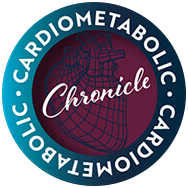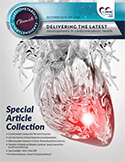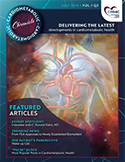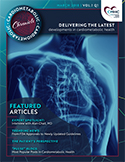Genetic testing is one of the cornerstones of personalized medicine, and while this approach has made significant strides in other therapeutic areas, such as cancer, the utility and applicability of genetic testing in cardiometabolic disease remains a novel area of investigation. However, there are certain high-risk familial cardiometabolic conditions where genetic testing is currently a viable approach to care, and in several other areas of cardiometabolic medicine this approach is gaining momentum. We discussed the current state of genetic testing for cardiometabolic health and much more with Elizabeth McNally, MD, PhD.
CARDIOMETABOLIC CHRONICLE: When we talk about genetic testing in cardiometabolic disease, it definitely encompasses several therapeutic areas, but what are some of the disease states that we have a good understanding about the role of genetics as a driver of disease development and progression?
DR. MCNALLY: There are at least two broad approaches to genetics right now, one is known as genetic risk score or polygenic risk scores and the second involves sequencing genes. Polygenic risk scores gather information from genome-wide association studies and association studies to estimate the risk of cardiovascular disease. This type of testing might help predict risk for coronary artery disease, metabolic syndrome, diabetes and atrial fibrillation, and the field is working towards implementing this type of testing into clinical practices. In the second approach, we sequence a small panel of genes, maybe 50- 150 genes, and then predict risk of disease, including that of genetic cardiomyopathy and heart failure in the patient. Gene sequencing helps us to sub-classify types of cardiomyopathy, heart failure and in particular who is at risk for developing specific types of complications, for instance, arrhythmia risks. These are really two completely different types of genetic testing. Genetic risk scores can be done on anybody and at any age to help them predict their lifetime risk of developing coronary artery disease or other cardiovascular conditions, while the second approach is more specific genetic testing for individuals who have a personal or family history of cardiomyopathy or heart failure to help them whether they have the same risk as their family members.
CARDIOMETABOLIC CHRONICLE: In addition to family history, what other factors should clinicians look for to determine whether a patient would benefit from genetic testing?
DR. MCNALLY: There a few areas where we are doing panels of genes regularly. In our center, any person under the age of 60 with non-ischemic dilated cardiomyopathy will usually have gene sequencing, given that the success of this testing is now up to around 30-50%. Usually these patients are worried about the occurrence of these diseases in their family members, hence in those cases, these tests help them to not only identify what their diagnosis is, and sometimes how to manage it better, but also this information is quite powerful to predict the chances of risk for their family members.
We also offer genetic testing in different types of inherited aortic disease, in younger individuals who have thoracic aneurysms, certain types of arrhythmia syndromes, and neuromuscular disease. It’s especially important for neuromuscular diseases like myotonic dystrophy and related disorders that have cardiac complications predicted by their gene mutation status. Many times, we see patients who often have cardiometabolic presentations, also have involvement of their skeletal muscles, and often that diagnosis is missed because we’re not trained to think beyond our own discipline. So sometimes when patients have a little bit of muscle weakness, then that can actually be a very meaningful symptom and can lead to a diagnosis. So, there are a bunch of areas in which we’re doing testing having to do with people under a certain age, usually under the age of 60 and presenting with unusual symptoms.
CARDIOMETABOLIC CHRONICLE: Crossing over into the lipid space and cardiovascular risk, there have been a few developments with genetic testing in this area as well.
DR. MCNALLY: Indeed. Familial hypercholesterolemia (FH) is a condition that has very clear genetic incidence but is generally underdiagnosed and probably treated later in life that it should be because of underdiagnosis. There hasn’t been as much use of genetic testing for FH, probably because of clinicians’ attitudes which focuses on treating people with statins without knowing their genetic background. Here, I would suggest that it is actually really useful to know who carries genetic mutations that predispose to familial hypercholesterolemia. Within families with dominant FH, 50% of the people will not carry the risk, so we would really want to tailor our therapies towards those who need it. In principle, based on genetic screening, we could identify people very early in life who should benefit from being on statins. Gene panels for FH are expanding and include genes beyond just the LDL receptor. Hence, this testing useful for the diagnosis as well as their proper management of patients with FH.
CARDIOMETABOLIC CHRONICLE: Are there disparities in genetic testing and how can we get past them?
DR. MCNALLY: That is a really great question. A lot of genetics has been done on people of European or Caucasian ancestry. One of the biggest studies that is yielding a lot of genetic information right now is UK biobank. However, this biobank has data almost exclusively from people with white or Caucasian background. So, the disparity arises in the use of genetic risk scores, as they are very useful in Caucasians or people of white European descent, but their utility beyond this population remains to be evaluated. Hence, one of the big questions is, how do we apply those better to more diverse populations?
If we look at the population in the United States, we have a very mixed and diverse population particularly among younger people, and this is where we’d ideally like to apply some of this genetic risk scores to identify diseases early in life, so we can make changes in lifestyle and medications for appropriate disease management. Therefore, we have to figure out how to make these risk scores and genetic testing work for people from an incredibly diverse population. We’re working very hard on that problem.
CARDIOMETABOLIC CHRONICLE: Are there challenges in interpreting the information that comes from genetic testing and what it may mean for patient care?
DR. MCNALLY: Typically, three types of answers can be attained with genetic testing. Genetic testing results are interpreted as pathogenic or likely-pathogenic mutations. Sometimes the result is benign, and this type of genetic result is not included on the test report. But then we have a middle area, a gray zone, which we call ‘variants of uncertain significance’. We can see this type of result in anyone, but those from non-Caucasian backgrounds have an increased chance of getting this type of result. I think it’s important for clinicians who might be working with a variant of uncertain significance result, to work a little bit harder with that patient and that family to try to interpret that result in a better way. That often includes getting clinical information from family members to figure out who else has that disease and then making sure that they get tested. It is also really important to work with a genetic counselor to determine whether that variant is actually pathogenic or non-pathogenic. So, when interpreting a variant, you may have to work a little harder to get to a conclusion.
Additionally, the availability of large databases, including large publicly-accessible data, contain genetic testing results. This type of information really helps in the interpretation of these results. In the last few years, the large genetic testing companies have generally made all their data available through these databases. That has helped us to improve the quality of the interpretation across all populations.
CARDIOMETABOLIC CHRONICLE: In the future, how do you envision the role of genetic testing and even polygenic risk scores in the care for patients with the cardiometabolic disease?
DR. MCNALLY: I think we’ll probably see some increase in genetic risk scores and polygenic risk scores. Cost is much less of a barrier, with high throughput technologies reducing costs. I think in some settings what we will see is a blending of the tests with gene panels integrated with polygenic risk scores. If we imagine a world where the cost of testing is $50-100, many people would choose this. Of course, it depends what you get for that price, but ancestry testing has already shown us that people are interested in this information. One could envision doing this type of testing fairly early in life, of course on a voluntary basis, and knowing some degree of lifetime risk of different diseases. We have seen that having this genetic information has empowered a lot of patients and their family members to personally manage their daily lifestyles, for instance, including exercise and suitable diet as part of their chronic disease management. The data can be incredibly empowering for people and I think that’s what we will see going forward.






















